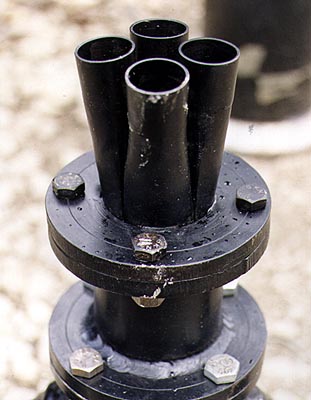|
The Lempor Exhaust Ejector Few with more than a passing interest in steam traction will not have heard of the Argentine engineer L.D.Porta and his life long quest to improve the efficiency of the steam locomotive. The Lempor Exhaust Ejector was one of his more significant and increasingly widely used inventions.
A typical Lempor Exhaust Ejector (Shaun McMahon photo) How it works The engine exhaust steam is piped from each cylinder via a manifold to a fitting placed immediately below the blast nozzles. Termed a "Kordina" after the Russian engineer who designed it, it has a central divider to keep separate the two exhaust streams and prevent one cylinders exhaust pulse from increasing the backpressure in the other. The divider ends below a blast pipe, allowing a partial vacuum to be created in the opposite cylinders manifold pipe each time an exhaust pulse of steam goes by from the other cylinder. Each cylinder therefore exhausts into minimal back pressure. The two exhaust streams are combined in the blast pipe, expanded to near atmospheric pressure and directed into the four Lempor exhaust nozzles. The cross-sectional area of the blast pipe should equal that of the exhaust nozzles. The four nozzles act to split the blast into separate streams to entrain and accelerate smokebox gases within the mixing chamber. They discharge at the point of entry of the mixing chamber bell mouth. Full sized Lempor blast nozzles are of "converging - diverging" section (look up "DeLaval nozzle") and the speed of the steam flow will be near supersonic as it passes through the nozzles. On miniature locomotives the nozzles may have a parallel bore with no detriment to performance (my opinion, if you can prove otherwise please let me know). At the top of the mixing chamber the choke forms the entry to the diverging cone of the diffuser. The high-speed, low pressure column of steam and gas is converted within the cone into a slower moving higher pressure column as it exits the top of the diffuser. The general principles of this action are the same as that of a boiler-water injector delivery cone. The upward speed of the gas flow from the top of the diffuser is sufficiently slow that smoke lifting "Elephant Ears" are required fittings on many Lempor fitted mainline engines to stop drifting smoke from obscuring the driver's view forward. The benefit of the ejector is to lower the exhaust steam back-pressure for greater cylinder power output while improving exhaust gas pumping efficiency. You can configure an individual installation to either reduce the back pressure for a given draught or increase the available draught, often both at the same time if the original draughting installation was poor. Taken from Michael Guy's website. To read more click here
Below, courtesy of Australian, Richard Stuart and Canadian, Michael Guy is a link to an Excel spread sheet to enable the hobbyist to examine the mathematics of the design process for themselves. Lempor ejector calculator beta 1.1.xls Notes: If you are asked for a password to open the file, click cancel in the pop up box. The file may take a couple of seconds to open, depending on bandwidth availability etc. After "clicking", please be patient. Once open, It is suggested that you save the file to your local hard drive for more efficient future use.
|
